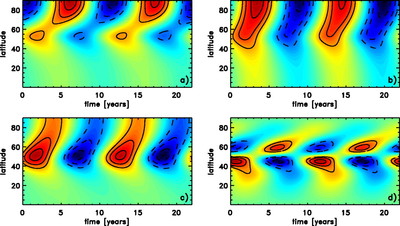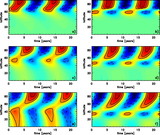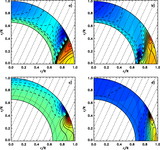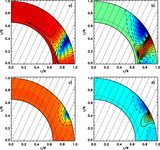Image Details

Caption: Fig. 3.
Influence of viscosity and meridional flow on the poleward propagation of zonal flow variations. Panels (a) and (b) compare two models with different values of the turbulent viscosity, (a) ﹩\nu _{t}=3\times 10^{8}\ \mathrm{m}\,^{2}\ \mathrm{s}\,^{-1}﹩ and (b) ﹩\nu _{t}=1.2\times 10^{9}\ \mathrm{m}\,^{2}\ \mathrm{s}\,^{-1}﹩. A higher value of the turbulent viscosity leads to a faster poleward propagation of the flow pattern. Both cases show the response to a periodic mechanical forcing at 45° latitude. Panel (c) shows the same model as (a); however, the meridional is not allowed to change in response to the zonal flow variation. In this case the maximum amplitude coincides with the location of the forcing region and the velocity of the poleward propagation of the signal is reduced. Panel (d) shows the variation of meridional flow pattern (the reference state meridional flow is subtracted) associated with poleward moving zonal flow pattern shown in (a). The amplitude of the meridional flow variation is around 0.2 m s−1 for a solar‐like zonal flow variation of around 4 nHz at the pole.
Copyright and Terms & Conditions
© 2007. The American Astronomical Society. All rights reserved. Printed in U.S.A.









